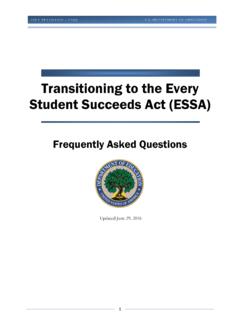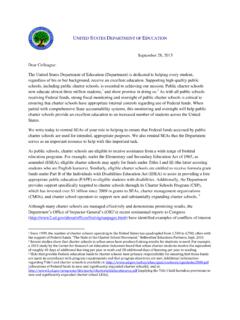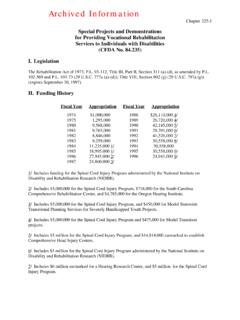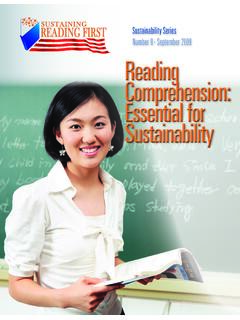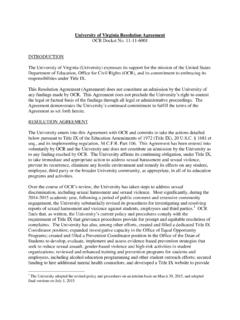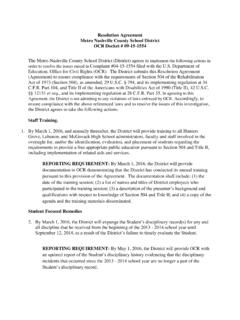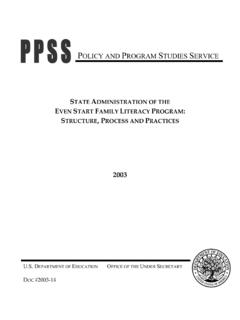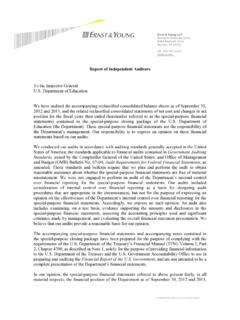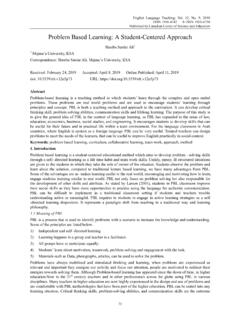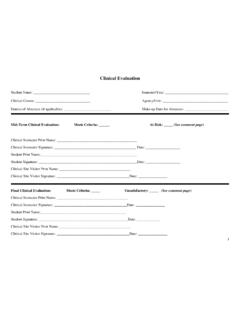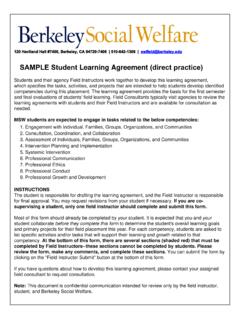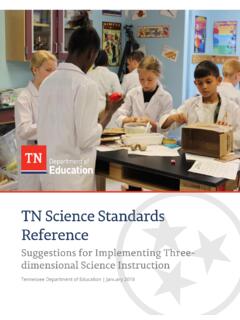Transcription of My vision for family engagement is ambitious… - ed
1 Partners in Education: A Dual Capacity-Building Framework for family School Partnerships Partners in Education A Dual Capacity-Building Framework for family School Partnerships A publication of SEDL in collaboration with the Department of Education i Partners in Education: A Dual Capacity-Building Framework for family School Partnerships 2013 Copyright by SEDL. Funding for this publication is provided by the Department of Education, contract number ED-04-CO-0039/0001. ii Partners in Education: A Dual Capacity-Building Framework for family School Partnerships My vision for family engagement is ambitious.
2 I want to have too many parents demanding excellence in their schools. I want all parents to be real partners in education with their children's teachers, from cradle to career. In this partnership, students and parents should feel connected and teachers should feel supported. When parents demand change and better options for their children, they become the real accountability backstop for the educational system. ARNE DUNCAN, SECRETARY OF EDUCATION, MAY 3, 2010. 1. Partners in Education: A Dual Capacity-Building Framework for family School Partnerships 2.
3 Table of Contents The Dual Capacity-Building Framework for family School The Opportunity Conditions ..9. Policy and Program Goals .. 10. Staff and family Partnership 11. The Three Case 13. Stanton Elementary 13. Boston Public 16. First 5 Santa Clara 19. Conclusion and 25. 27. About the 28. 3. Introduction For schools and districts across the , family engagement is rapidly shifting from a low-priority recommendation to an integral part of education reform efforts. or schools and districts across the , fam- school leadership, a high-quality faculty, communi- ily engagement1 is rapidly shifting from a ty engagement and partnerships, a student- centered low-priority recommendation to an integral learning climate, and effective instructional guidance part of education reform efforts.
4 family engagement for staff (See Figure 1 on page 6).6 In particular, has long been enshrined in policy at the federal level research shows that initiatives that take on a partner- through Title I of ESEA (Elementary and Secondary ship orientation in which student achievement and Education Act), which requires that Title I schools school improvement are seen as a shared responsibil- develop parental involvement policies and school ity, relationships of trust and respect are established family compacts that outline how the two stakeholder between home and school, and families and school staff groups will work together to boost student achieve- see each other as equal partners create the conditions State governments are increasingly adding their for family engagement to voices to the chorus.
5 As of January 2010, 39 states and the District of Columbia had enacted laws calling for the implementation of family engagement Over 50 years of research links the various roles In 2012, Massachusetts was one of several states to integrate family engagement into its educator evalu- that families play in a child's education as ation system, making family and community engage- supporters of learning , encouragers of grit and ment one of the four pillars of its rubric for evaluating determination, models of lifelong learning , teachers and and advocates of proper programming and These policies are rooted in a wide body of research placements for their child.
6 Demonstrating the beneficial effects of parental involve- ment and family school partnerships. Over 50 years of research links the various roles that families play in a Given this research base, the increase in policies child's education as supporters of learning , encour- promoting family engagement is a sign of progress agers of grit and determination, models of lifelong toward improving educational opportunities for all learning , and advocates of proper programming and children. Yet these mandates are often predicated on placements for their child with indicators of student a fundamental assumption.
7 That the educators and achievement including student grades, achievement test families charged with developing effective partnerships scores, lower drop-out rates, students ' sense of personal between home and school already possess the requisite competence and efficacy for learning , and students ' skills, knowledge, confidence, and belief systems in beliefs about the importance of Recent other words, the collective capacity to successfully work by the Chicago Consortium on School Research has implement and sustain these important home school also shown that parent and community ties can have relationships.
8 Unfortunately, this assumption is deeply a systemic and sustained effect on learning outcomes flawed. Principals and teachers receive little training for children and on whole school improvement when for engaging families and report feeling under-pre- combined with other essential supports such as strong pared, despite valuing relationships with 5. Partners in Education: A Dual Capacity-Building Framework for family School Partnerships Parents, meanwhile particularly low-income and among educators and families to partner with one limited-English-proficient parents face multiple another around student success.
9 Based in existing barriers to engagement , often lacking access to the research and best practices, the Dual Capacity- social capital and understanding of the school system Building Framework for family School Partnerships is necessary to take effective action on behalf of their designed to act as a scaffold for the development of Without attention to training and capacity family engagement strategies, policies, and programs. building, well-intentioned partnership efforts fall flat. This is not a blueprint for engagement initiatives, Rather than promoting equal partnerships between par- which must be designed to fit the particular contexts ents and schools at a systemic level, these initiatives in which they are carried out.
10 Instead, the Dual default to one-way communication and random acts of Capacity-Building Framework should be seen as a engagement 10 such as poorly attended parent nights. compass, laying out the goals and conditions neces- sary to chart a path toward effective family engage- This paper presents a new framework for designing ment efforts that are linked to student achievement family engagement initiatives that build capacity and school improvement. Figure 1: Five Essential Supports The University of Chicago Consortium on Chicago School Research11.
